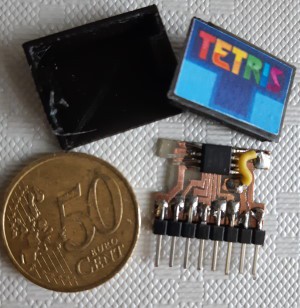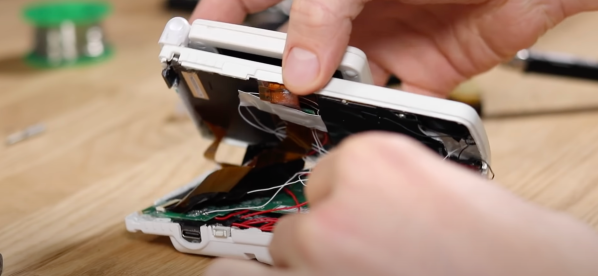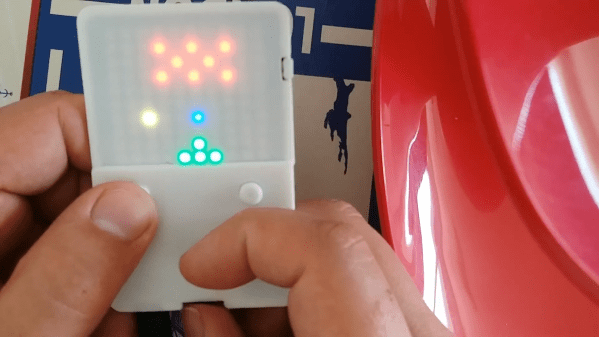
[Jowan] sent in this excellent gameboy cartridge hack. The cartridge contains 1MB of flash and an 8 bit serial I/O interface. He’s using it to play percussion with some solenoids and a custom rom. If you guys like it, he might be convinced to put together a how-to on hacking the cartridge.
Game Boy Advance MIDI Interface

[Avelino Herrera Morales] wrote in to tell us about his Game Boy Advance MIDI project. It’s pretty neat since it only takes two resistors and a link cable to use. The link cable has a slotted connector so you can use a chunk of protoboard to connect to the pins. He has software the does all of the MIDI packet generation. As an example, he uses the GBA to control a Chameleon synthesizer.
2024 Tiny Games Contest: Neat PCB Business Card Was Inspired By The Arduboy
The humble business card is usually a small slip of cardboard with some basic contact details on it — but as hackers know, it can be so much more. [Marian] has provided us a great example in the form of his own digital business card, which doubles as a handheld game!
Wanting to make his business card more interesting for better engagement, [Marian] was inspired by the Arduboy to give it some interactivity. He chose the STM32G030F6 microcontroller as a cheap and reliable option to run his business card. He then created a 10×9 LED matrix display using Charlieplexing to minimize the amount of I/O pins required. For controls, he went with the usual directional cross plus two action buttons. He implemented a variety of games on the card—including a Flappy Bird clone and a game similar to the classic Simon toy.
Files are on GitHub for the curious. We’ve featured some other great business cards this year, too. Indeed, we ran a whole challenge! If you’re cooking up your own exemplary little PCB to hand out at conferences, don’t hesitate to let us know!
2024 Tiny Games Contest: ATtinyBoy Does It With Tiny Cartridges
What is it about tangible media? There’s just something neat about having an individual thing that represents each game, each album, each whatever. Sure, you can have a little console with a thousand games loaded on it, but what’s the fun in that?
 Enter the ATtinyBoy. [Bram]’s entry into the Tiny Games Contest is based on the ATtiny85, and the whole thing is smaller than a credit card. In fact, each little game cartridge contains its own ATtiny85, with the pins broken out into headers.
Enter the ATtinyBoy. [Bram]’s entry into the Tiny Games Contest is based on the ATtiny85, and the whole thing is smaller than a credit card. In fact, each little game cartridge contains its own ATtiny85, with the pins broken out into headers.
That is, although the schematic is based on [Billy Cheung]’s gametiny, which uses an ATtiny85 as the brain, ATtinyBoy’s brain is divided among each of the games.
This certainly checks a lot of boxes when it comes to contest rules and requirements, and it’s just awesome besides. We particularly like the custom box that holds ATtinyBoy and all his distributed knowledge. If you want to make one of your own, the schematic, code, and STLs are all available over on IO.
Orange FM Brings Radio To The GameBoy
We’ve all been there. You left your Walkman at home and only have your trusty Game Boy. You want to take a break and just listen to some tunes. What to do? [orangeglo] has the answer now with the Orange FM cartridge.
This prototype cart features an onboard antenna or can also use the 3.5 mm headphone/antenna port on the cartridge to boost reception with either a dedicated antenna or a set of headphones. Frequencies supported are 64 – 108 Mhz, and spacing can be set for 100 or 200 kHz to accomodate most FM broadcasts setups around the world.
Older Game Boys can support audio through the device itself, but Advances will need to use the audio port on the cartridge. The Super Game Boy can pipe audio to your TV though, which seems like a delightfully Rube Goldberg-ian way to listen to the radio. Did we mention it also supports RDS, so you’ll know what that catchy tune is? Try that FM Walkman!
Can’t decide between this and your other carts? Try this revolving multi-cart solution. Have a Game Boy that needs some restoration? If it’s due to electrolyte damage, maybe start here?
Cramming A DS Inside A Gameboy
Many holiday recipes and console hacks share a common theme: cramming a thing inside another thing. Whether it’s turducken or a Nintendo DS inside a Gameboy, the result is always unexpected. The chassis for this mod is a humble Gameboy color with a Gameboy SP screen tackled on the top to serve as the secondary display. Unfortunately, this mod lost touch screen functionality, limiting some of the games you can play.
[TheRetroFuture] received the custom handheld from [GameboyCustom], which was somewhat damaged in shipping. The original screw mounts had to be removed and the case glued back together to fit the DS motherboard. So for [TheRetroFuture] to get inside to start troubleshooting involved a razor blade and patience. Testing various points and swapping components got [TheRetroFuture] closer to the root problems. The fix ended up being a few wires that came loose during shipping. Finally, after reseating a display connection and some careful soldering, it booted and started playing games.
Overall, it’s pretty impressive to see Mario Kart DS running on both screens on the tiny handheld. But you might be asking, why? Why shove one handheld inside another handheld? Sometimes it’s to gain new functionality like this Raspberry Pi inside a PSP body. Sometimes, it’s just because we can. Video after the break.
LEDBOY Is A Retro-Modern Handheld Game
Back in the 1970s, there were a few LED-based games on the market that were quickly superseded by the rise of LCDs and other fancier technologies. However, [grossofabian] wanted to recreate that classic style of game but with more modern hardware. The result is the LEDBOY, a colorful handheld game built in tribute to that era.
The handheld is based around the ATtiny 1614 microcontroller, driving a 10×10 array of NeoPixel Nano 2427 LEDs, named for their small 2.4 mm x 2.7 mm form factor. They’re RGB, too, so there’s lots of wonderful colors to play with.
Wrapped up in a neat enclosure with a rechargeable 130 mAh lithium-ion battery and some simple tactile buttons, it’s a tidy little handheld game console. Add in the CH340C chip for USB to serial duties, and it’s easy to program with the Arduino IDE, too.
Code is available on Github for those keen to take a closer look. Amusingly, the project bears a striking resemblance to a similarly-named build we featured just under 12 years ago. Time is a flat circle, and the video, my friends, is after the break.

















